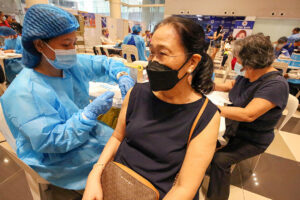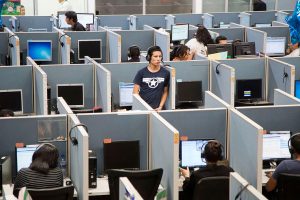Good buy or goodbye?

Obviously, we are learning to live with COVID-19. But at the same time, we seem to get bogged down in our efforts to leap forward. New variants come and go, and some linger longer than others. Meanwhile, vaccine effectiveness also wanes over time. And while quite a number of people have received vaccine boosters, I believe the majority have not.
In this line, perhaps those willing among the adult population in general should already be allowed to get first and second boosters, rather than “reserving” the present stock of vaccines for the effort to fully vaccinate (three doses) against COVID-19 the entire population in the next three months. The issue is time-bound: a big portion of the local stock expires this month.
I therefore support calls for the Department of Health (DoH) to temporarily go beyond prioritizing A1, A2, and A3 for second boosters. I believe A4 and the Rest of the Adult Population should be allowed to jump the cue, just this time. Second boosters, temporarily, should no longer be limited to just healthcare workers, senior citizens, and immunocompromised individuals.
It is in this light that I find interesting the April 2021 Working Paper by University of Chicago economist Casey Mulligan titled, “The Backward Art of Slowing the Spread? Congregation Efficiencies during COVID-19.” Mulligan analyzed data to test the presumption used to justify lockdowns and stay-at-home orders — that the workplace was less safe than the home.
He found that in many instances in the United States, workplaces actually became safer than homes because businesses had the incentive or the motivation as well as the capital to invest in so-called “mitigation protocols,” to ensure workers’ safety, and to allow for continued business operations. On the other hand, households were less likely to adopt similar levels of precaution and actually go beyond the minimum.
“The available data from schools, hospitals, nursing homes, food processing plants, hair stylists, and airlines show employers adopting mitigation protocols in the spring of 2020. Coincident with the adoption, infection rates in workplaces typically dropped from well above household rates to well below,” he noted.
“When this occurs, the sign of the disease externality from participating in large organizations changes from negative to positive, even while individuals continue to have an incentive to avoid large organizations due to the prevention costs they impose on members. Rational cooperative prevention sometimes results in infectious-disease patterns that are opposite of predictions from classical epidemiology,” Mulligan wrote.
He added, “Micro evidence contradicts the public-health ideal in which households would be places of solitary confinement and zero transmission. Instead, the evidence suggests that ‘households show the highest transmission rates’ and that ‘households are high-risk settings for the transmission of [COVID-19]’.”
Moreover, “schools, businesses, and other organizations implemented a range of prevention protocols — from adjusting airflow to installing physical barriers to monitoring compliance to administering their own testing services — that households did not, and perhaps could not. Something in these organizations greatly reduced the spread.”
For expiring vaccines, perhaps we can waive the priority list. Over 1.5 million vaccine doses bought by the private sector are set to expire by the end of July, said Go Negosyo founder Joey Concepcion, who wants the DoH to allow second boosters particularly for workers. “If you look at these expiring vaccines, that’s a lot of money. Yes, we have to focus on the first boosters, but the private sector bought these vaccines. This is my frustration.”
Of the total expiring vaccines in warehouses, over 628,000 doses are AstraZeneca ($5 each dose), while 887,000 doses are Moderna ($27 each dose). These were bought under a tripartite agreement among the private sector, vaccine makers, and the government — and where half of the vaccines acquired go to the government for distribution to the public for free.
“The vaccines should be used rather than left to expire. Many productive members of the workforce fall outside of the age limit set by the HTAC. Yet they also have risk factors and are exposed to the virus every day when they come to work,” Concepcion told a press forum, as reported by the Philippine Star.
He added, “The private sector has already proven that it is willing to get vaccinated. There is no need for mandates when it comes to the private sector. They don’t want to get sick and use up their sick leaves…[But] the sense of urgency is not there. Government is trying to do its best, but there is this body that is moving quite slow.”
DoH data indicate over 65 million Filipinos have been fully vaccinated, but only about 15 million for them have gotten their first booster as of July 17. Some estimates put at 71 million the number of vaccinated people. But the booster uptake has been slow, for some reason. In Makati City, for instance, vaccination sites have been operating at below 30% capacity.
In fact, the SM Makati vaccination site is already scheduled to be closed by end-July. The same goes for the Nayong Pilipino Mega Vaccination Site. I believe a number of other vaccination sites in Metro Manila are all winding down operations and are just depleting present stocks — many of which are probably about to expire this July or early August.
“We asked the private sector to buy the vaccines but now they are given difficulties in using the vaccines that they bought. Do we want the people to get vaccinated illegally? … Clamor to allow a second booster has been there for months. But it seems nobody is listening,” noted Iloilo Rep. and former Health Secretary Janette Garin, who is also pushing for second boosters for the general population.
Garin presents a more dire scenario: she claims that only 152 million out of 245 million vaccine doses procured by the government have been administered. And, not only 1.5 million but actually four million doses bought by the private sector were about to expire. While another 23 million doses donated and procured by the government were also set to expire.
Whose numbers are more precise is anybody’s guess. But, no matter how the issue is viewed, Concepcion and Garin present compelling arguments against wasting resources and opportunities. And with only 10 days left in the month, for sure millions of expensive COVID vaccine doses will soon end up in the bin. Public and private money all down the drain.
Marvin Tort is a former managing editor of BusinessWorld, and a former chairman of the Philippine Press Council




